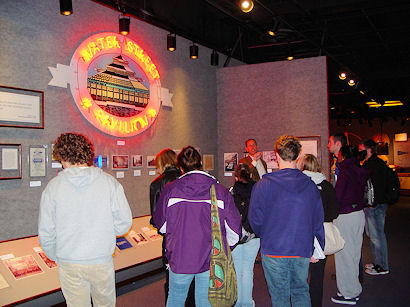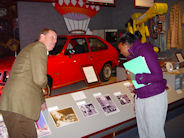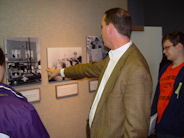UM-Flint History Students Take on "Museum Makeover"

A University of Michigan-Flint history class is working with two area museums to get a better understanding of how what happened locally relates to the broader history of the country.

Students from Assistant Professor Thomas Henthorn's History 221, United States Since 1898, are working with the Sloan Museum and Whaley House Museum to complete one of their writing assignments. The students will be conducting a "museum makeover" of both locations. The class will pick a topic, develop an argument, and then identify parts of the museum displays as evidence to support their argument. Instead of writing an essay, however, students must write a series of museum labels (those little captions next to museum displays) to present their argument.
"The point of the assignment," according to Henthorn, "is to get students to broaden the narrative of local history by understanding how local people and places are connected to larger developments within American History. Both the Whaley House Museum and Sloan Museum provide excellent examples of recurrent themes in modern American history such as industrialization, technological change, urbanization, the labor movement, and civil rights. This type of writing also forces students to think critically about their writing. Museum labels have word limits. Therefore, students will have to choose their words carefully when making an argument."

"The partnership between the University of Michigan-Flint's History Department and the Whaley House Museum connects the Kearsley Street of past and present, and exposes students to the history and historical resources of the community," according to Andrew Clark, director of the Whaley House Museum. "Of great benefit to us here at the museum is that it provides a perspective and different form of input that we don't usually receive from our visitors."
Tim Schickles, the director of the Sloan Museum and Longway Planetarium, has been working with Henthorn for the past year. He said the program will allow students to work with original documents and on real community projects.
"Students working in this program are not simply working on exercises that will earn them a grade and credits, but more importantly, they are providing a service to the community," noted Schickles.
The best student work will be on display at the Whaley Historic House Museum and Sloan Museum.
"This type of assignment demonstrates what types of partnerships are available for faculty at the University of Michigan-Flint. We have numerous resources here in Flint that allow our students to learn about their world in very meaningful ways," stressed Henthorn.
Related Posts
No related photos.
UM-Flint News
The Office of Marketing & Communications can be reached at [email protected].